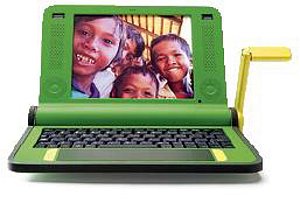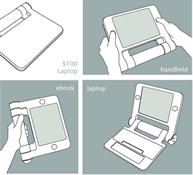I want to teach the world to surf in perfect harmony
 Updated January 2, 2006
Updated January 2, 2006It is exciting to work on so many new ways to solve problems with new technology. It is also easy for this excitement to come at the expense of putting time into addressing a giant local AND global problem, the digital divide. The biggest global Information Technology issue is solving the problem of how to radically grow the base of the cyberspace literate, to reduce the drag on the economy by increasing the number of participants in the global digital economy.  One solution is now past mirage status. Negroponte's project to get the MIT $100 laptop out the manufacturing door is looking great (see and click pictures on left or right for more pictures and information, credit to MIT Labs for pictures). What can we do to help evangelize? Know and tell. The story first broke into major news feeds with the September 28, 2005 Emerging Technology Conference at MIT. A physical model was shown at the World Summit on the Information Society (WSIS) took place in Tunis, Tunsia, Nov. 16-18, 2005. It was announced in December 2005 that Taiwan's Quanta, the world's largest manufacturer of laptops, will make the first ones available in the fourth quarter of 2006. Keep hope alive.
One solution is now past mirage status. Negroponte's project to get the MIT $100 laptop out the manufacturing door is looking great (see and click pictures on left or right for more pictures and information, credit to MIT Labs for pictures). What can we do to help evangelize? Know and tell. The story first broke into major news feeds with the September 28, 2005 Emerging Technology Conference at MIT. A physical model was shown at the World Summit on the Information Society (WSIS) took place in Tunis, Tunsia, Nov. 16-18, 2005. It was announced in December 2005 that Taiwan's Quanta, the world's largest manufacturer of laptops, will make the first ones available in the fourth quarter of 2006. Keep hope alive.
 One solution is now past mirage status. Negroponte's project to get the MIT $100 laptop out the manufacturing door is looking great (see and click pictures on left or right for more pictures and information, credit to MIT Labs for pictures). What can we do to help evangelize? Know and tell. The story first broke into major news feeds with the September 28, 2005 Emerging Technology Conference at MIT. A physical model was shown at the World Summit on the Information Society (WSIS) took place in Tunis, Tunsia, Nov. 16-18, 2005. It was announced in December 2005 that Taiwan's Quanta, the world's largest manufacturer of laptops, will make the first ones available in the fourth quarter of 2006. Keep hope alive.
One solution is now past mirage status. Negroponte's project to get the MIT $100 laptop out the manufacturing door is looking great (see and click pictures on left or right for more pictures and information, credit to MIT Labs for pictures). What can we do to help evangelize? Know and tell. The story first broke into major news feeds with the September 28, 2005 Emerging Technology Conference at MIT. A physical model was shown at the World Summit on the Information Society (WSIS) took place in Tunis, Tunsia, Nov. 16-18, 2005. It was announced in December 2005 that Taiwan's Quanta, the world's largest manufacturer of laptops, will make the first ones available in the fourth quarter of 2006. Keep hope alive.I'm helping with some small scale, special funding, 1-to-1 projects, including the Swain West Elementary School's laptop implementation and aid the 1-to-1 New Schools Project for Cherokee H.S.’s which seeks a wireless laptop for all in the High School. But I’ve not been able to see a tangible end game which would roll out the "digital pencil" to all students until the $100 laptop. At Sept. 28’s Emerging Technology Conference, announcements finally enabled us see a way to scale to meet the needs of the rest of our region (and the world). The $100 laptop project brought out its prototype in November and will and begin low scale production within a year. The project led by Negroponte to design, build and market a $100 laptop is coming much sooner than predicted a year or so ago. After following this story for many months, the story is really breaking into the popular press with hundreds of articles now available at Google News in the Sci/Tech section. Details can be found in the links below.
Here is a summary of key facts gleaned from this reporting so far. The laptop will: run the free Linux, Open Office productivity tools (similar to the Microsoft Office suite) and other free applications; require a minimum order of 1 million; provide no sales to individuals, only for students and teachers; have a prototype planned showing, November 2005, volume production late 2006; have 5 countries preparing to order 15 million of them; include an innovative wind-up power source; feature a 500 MHz processor and 1GB of onboard memory; be WiFi and cell phone-enabled and will have at least four USB ports; be foldable in different ways; have an AC adaptor cable that will double as a shoulder strap; be “able to switch from a full colour screen to a monochrome alternative, which will be much more easily viewed in bright sunlight; will provide alternate electrical power by turning a crank for one minute which will provide 10 minutes of power”; have a “non-profit One Laptop Per Child group which has ambitious plans to distribute 150 million laptops in three years.” be very rugged laptops, encased in bump-proof rubber "so that when it closes, it's hermetically sealed to protect it from the elements such systems might be subjected to (for example, in the jungles of Cambodia)". So, who would not want one of these.
- http://laptop.media.mit.edu/laptop-images.html
- http://laptop.media.mit.edu/news.html
- http://www.redherring.com
- http://www.techworld.com
- http://www.pcmag.com
- http://www.techtree.com/
- http://news.independent.co.uk/world/science_technology/
- http://www.vnunet.com/vnunet/news/
"The production figures he is citing are well ahead of the current manufacturing technology currently," Enderle said. "They are talking about numbers that exceed the manufacturing capacity of the segment by a couple of times."
Enderle said Tier 1 laptop vendors don't have anything to worry about just yet. There is a long way to go before the $100 laptop becomes viable. Besides production capacity, there are questions of user education and simple electricity.
Hundred-Dollar Laptop Prototype Set for November Release, LinuxInsider, http://www.linuxinsider.com/story/LRXq2uF6eQmrG2/Hundred-Dollar-Laptop-Prototype-Set-for-November-Release.xhtml
====
My own analysis is that this will be a far more disruptive technology to existing corporations than industry pundits and computer executives expect. Enderle’s argument that production capacity is not available is both true and meaningless. Creating or repurposing factories for this purpose can happen quickly. Once the design stabilizes within the next year, and people realize that sufficient software exists for the Linux OS (browsers, productivity tools, basic media tools) then the Asian companies that have been doing knock-offs of famous world brands for a long time will get involved, build more production capacity, create something software compatible (since it uses the free open source Linux OS) and sell it to individual buyers even cheaper than MIT's concept. As the foundation directing distribution does not want to sell to retail outlets, only to governments a million at a time, there is a built-in incentive for competitive models to emerge. I know I want such a ruggedized machine.
Little is being said about how data storage is being handled for when the computer turns off. The answer is that the capacity will be limited to a gigabyte of flash memory, with no DVD drive or floppy drive as motors break too easily and cost too much, but if one also stores data for free on the net in some account space (I’m thinking Google which is an MIT partner in the project and already does this), who cares about limited space on the computer itself. Further, reports elsewhere show that Google has been on a buying spree picking up inexpensive fiber lines, experimenting with small city projects for free wireless and buying companies that handle other forms of net delivery such as Internet over power lines, so new solutions for net connection may suddenly appear as well. There is much more to this story that has yet to surface.
This news raises a number of questions. Should states and countries be encouraged to take part in the early rounds of buying? How does one build the political momentum to do so? Would a joint statement to the media by those engaged in 1-2-1 initiatives about why they see the 1-2-1 initiative important and what the $100 laptop design would enable be helpful on the larger state scene in motivating local leaders to think about how all grade levels might get such units? What new curriculum developments would build on such a base to help educators and learners take better advantage of such technology and the networked global economy?
Evangelize. Our schools need your help.
Comments